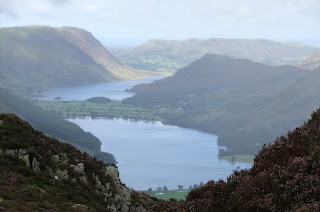Haystacks & Fleetwith Pike
It was a grey, damp and misty day as we headed off to the meeting point - a 'pay' car park behind Honister Youth Hostel. It always seems to take longer than you think for, travelling along lakeside roads, especially if following a bus or a car whose occupants are admiring the scenery. So, as we arrived (just in time), a good crowd had already assembled for the walk up Haystacks which was to be led by Lake District National Park volunteer rangers. We'd looked at the forecast on the MWIS website earlier in the morning and it was indicating that the weather was going to improve with good visibility later.We walked through the Honister slate mine car park and took the bridleway and then the path which followed the line of the long since dismantled tramway. It was a steady climb up, with rough cobbles and stone underfoot. I was pleasantly surprised to find that I was not finding it as difficult as I thought I might - hurrah! (We had walked down the tramway two years previously and I had thought then that coming up it would be tiring.) We paused at Drum House - we had to use our imagination - where the winding gear for getting slate trucks up and down the tramway had once been housed. Off to the left a distinct, soggy path snaked its way up and into the mist over Fleetwith. Our route continued along the tramway path before dropping down through the disused Dubs Quarry.
 |
| Buttermere, Buttermere Dubs and Crummock Water |
We had to carefully negotiate a stream which had become swollen from recent rainfall. Safely across, the footpath undulated generally upwards in a south westerly direction. Above Little Round How, we stopped for a quick coffee and a snack. It had a good view of Buttermere, Buttermere Dubs and, in the far distance, Crummock Water. There were signs of the weather improving and the mist starting to clear - even a glimpse of sunshine on a far fellside! On we went, with Blackbeck Tarn appearing to our left. A little further on, a balanced boulder caught our attention.
 |
| Balanced on Haystacks |
The landscape was not as I had imagined it - I don't know why. This route up Haystacks displayed a broad mass of rocky landscape. Now, looking at the OS map it's quite obvious.
 |
| Inominate Tarn |
Before long, we reached Inominate Tarn. A beautiful place - a rocky bowl filled with still water with Pillar appearing behind. From another viewpoint, Great Gable and Windy Gap could be seen clearly. There were plenty of people here. Even so, our group must have come as a bit of a shock to those who were already there. As we made our way to the summit cairn, we got a view of Ennerdale Water over to the west. At the summit there were 360 degrees of Lakeland felltops. No wonder AW. Wainwright favoured Haystacks so much. We retraced our steps to Inominate Tarn to eat our lunch. Many were up there to make the pilgrimmage. A D.of E. group, laden with large rucksacks, stopped for photos, closely followed by their supervisor. All too soon we were heading back along the way we had come. The stream that we had so carefully negotiated earlier in the day now had less water flowing down it. By now the mist had burnt off and it was a glorious day. We felt that we had to make the most of it.
 |
| Fleetwith Pike from Haystacks |
We had come prepared with OS map and compass, so, after thanking our volunteer leaders, we left the group. Our destination was Fleetwith Pike (a Wainwright) that we had seen from Haystacks, rising up majestically. We followed a mine track up through a disused quarry area devoid of plantlife. From here, we continued along a bearing up over rough and boggy fellside to the summit cairn and windshelter.
 |
| Fleetwith Pike summit |
 |
| Buttermere from Fleetwith Pike |
Fleetwith Pike gave us fabulous views down the length of Buttermere and beyond. Now Haystacks was bathed in sunshine. It was wonderful to be able to savour the views quietly in our own time. Our way along the ridge was clear. To the north, the ground fell away steeply. In a short time, we joined yet another mine track for a little way before rejoining the tramway that we had walked along earlier. As we descended, we were treated to great views of the fells to the east of Borrowdale.
We had had a great walk and been blessed with sunshine and amazing views. (A good packed lunch too!)
I'm sure we'll return to Haystacks;
... not because it's a Wainwright
... not because it's the final resting place of AW
... not to follow the many...
 |
| Haystacks from Fleetwith Pike |
...but (despite its modest height) it has great character, giving amazing views of its sometimes loftier neighbours. A place perhaps, near the stillness and serenity of Inominate Tarn, to contemplate...





































